
Cape Hatteras Light is a lighthouse located on Hatteras Island in the Outer Banks in the town of Buxton, North Carolina and is part of the Cape Hatteras National Seashore. It is the tallest lighthouse in the U.S. from base to tip at 210 feet. The lighthouse's semi-unique pattern makes it easy to recognize and famous. It is often ranked high on lists of most beautiful, and famous lighthouses in the US.
The Sands Point Lighthouse is located in the Incorporated Village of Sands Point in the Town of North Hempstead, in Nassau County, on the North Shore of Long Island, in New York, United States. The fourth lighthouse to be established on Long Island, this 1809 stone tower was built by an American Revolutionary War veteran who stayed on as its first keeper for many years. The Lighthouse is sometimes referred to the Mitchell Lighthouse, after Samuel L. Mitchell, the man who fought for it to be constructed.

The Cape San Blas Light is a lighthouse in the state of Florida in the United States. There were four built between 1849 and 1885. It was located at Cape San Blas in the northwestern part of the state. Due to beach erosion and weather damage over the decades, it was moved in 2014 to Port St. Joe. The lighthouse was listed on the National Register of Historic Places in 2015.

Boon Island Light is located on the 300-by-700-foot Boon Island off the southern coast of Maine, United States, near Cape Neddick. Boon Island Light has the distinction of being the tallest lighthouse in both Maine and New England at 133 feet (41 m). The lighthouse has a focal plane at 137 feet (42 m) above mean high water. The light's beacon flashes white every 5 seconds.
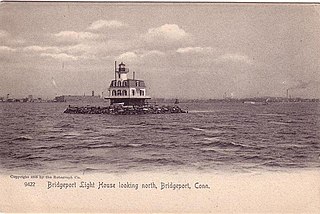
The Bridgeport Harbor Light, later the Bridgeport Harbor Lighthouse, was a lighthouse in Bridgeport, Connecticut, United States. It is located on the west side of the Bridgeport Harbor entrance and the north side of Long Island Sound. Originally constructed in 1851 and rebuilt in 1871 with a dwelling, it had a red-fixed light throughout its service life. The builder and first keeper of the light was Abraham A. McNeil who is also credited as improvising the first light for the Bridgeport Harbor in 1844. By 1953, the lighthouse was in poor condition and the United States Coast Guard opted to build a skeleton tower in its place. In the 2014 edition of the Light List Volume 1, the skeleton tower is marked as "Light 13A" with a height of 57 feet (17 m) and a visual marker of a square green dayboard with a green reflective border. The lighthouse was sold and an attempt was made to move it to serve as a monument for Connecticut's maritime history, but it was later decided to scrap the structure. The lighthouse caught fire and was destroyed during the dismantling in 1953.
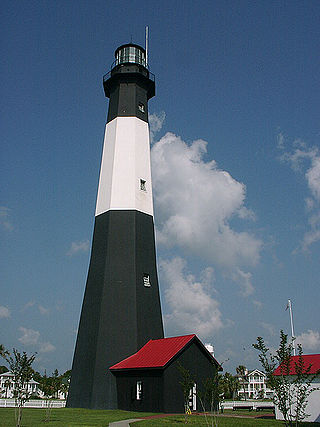
Tybee Island Light is a lighthouse next to the Savannah River Entrance, on the northeast end of Tybee Island, Georgia. It is one of seven surviving colonial era lighthouse towers, though highly modified in the mid 1800s.

Coney Island Light is a lighthouse located in Sea Gate, on the west end of Coney Island, Brooklyn, in New York City, east of New York Harbor's main channel.

North Dumpling Light is a lighthouse on North Dumpling Island in Long Island Sound off Fishers Island, New York. It was constructed in 1849, rebuilt in 1871, and deactivated in 1959, with the aid to navigation being moved to an automated metal tower placed nearby. The lighthouse itself and the grounds around it were sold to a private party. Around 1977, a new owner convinced the U. S. Coast Guard to return the light to the lighthouse and remove the skeleton tower.

Marblehead Light is situated on Marblehead Neck in Essex County, Massachusetts. The current tower is a skeletal structure that replaced the original 1835 brick and wood tower in 1895. It is the only tower of its type in New England; the next similar tower is to be found at Coney Island, New York. It was listed in the National Register of Historic Places, on June 15, 1987 as number #87001479 under Lighthouses of Massachusetts Thematic Group.
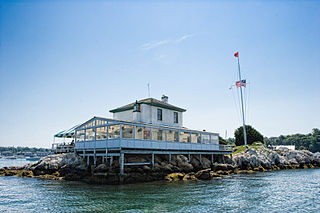
Ida Lewis Lighthouse, which was formerly the Lime Rock Lighthouse, is in the Newport harbor in Rhode Island. It is named after Ida Lewis, who lived and worked at the lighthouse from 1857 and was the official lighthouse keeper from 1879 until her death in 1911. She was celebrated for many acts of bravery in saving lives.
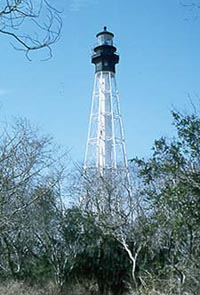
Cape Charles Lighthouse is an octagonal cast iron skeleton tower lighthouse at the mouth of the Chesapeake Bay on Smith Island which was officially removed from service in 2019. It is the tallest lighthouse in Virginia and the second tallest in the United States. This particular tower is the third lighthouse at this location. The first lighthouse at Cape Charles was a 55-foot (17 m) masonry tower completed in 1828. It was quickly deemed inadequate for its important seacoast location due to its low height and poor visibility at sea. It was soon threatened by erosion so in 1864 it was replaced by a 150-foot (46 m) masonry tower built further inland. Located a little more than a mile southwest of the old tower and 600 feet from the shoreline, the impressive 150-foot-tall conical brick tower was similar in appearance to the 1857 Cape May Lighthouse, painted white and topped with a dark brown lantern room. In 1892, a twenty-five-foot red band was painted around the white tower's midsection, about sixty feet up from the base, to make it more visible during the day. By the 1890s, it too was threatened by beach erosion which jetties built to protect it failed to halt, and with the lighthouse now only 300 feet from the ocean and the shoreline eroding at a rate of 37 feet per year it was decided that a third lighthouse needed to be built three quarters of a mile inland.
The Gull Rocks Light was a lighthouse at the entrance to Newport harbor northwest of Rose Island. A unique A-frame structure, it was supplemented with a skeleton tower in 1928.
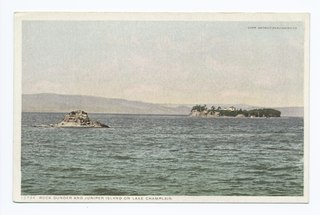
Juniper Island is a 13-acre (53,000 m2) island in Lake Champlain, approximately 3.15-mile (5.07 km) southwest of Burlington, Vermont's King Street Ferry Dock. The island is home to the Juniper Island Lighthouse. The State of Vermont purchased the island for $200 in 1825 and ceded it to the federal government. A 30-foot (9.1 m) brick tower and keeper's house were constructed. Up to that point, lanterns hung on trees by landowners up and down the lake had served navigation; this would be the first true lighthouse on the lake.
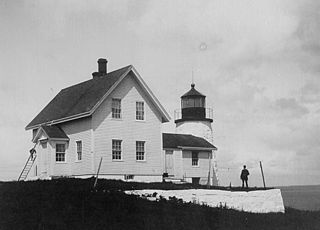
Eagle Island Light is a lighthouse on Eagle Island in Penobscot Bay, in south central Maine. The tower was first lit in 1838 but had to be torn down because of major physical defects. It was rebuilt in 1858 and operated by several families over the next century. In 1959 the light was automated, and five years later, over vehement local protests, the keeper's house was torn down and the bell was removed. The crew that removed the bell lost control of it, and it fell into the Bay. A Lobsterman salvaged it some years later and it is on exhibit on Great Spruce Head Island.

Libby Island Light is a lighthouse on Libby Island, marking the mouth of Machias Bay, in Machiasport, Maine. The light station was established in 1817 and is an active aid to navigation; the present granite tower was built in 1823 and improved in 1848. Libby Island Light was listed on the National Register of Historic Places as Libby Island Light Station on June 18, 1976.

Little River Light is a lighthouse on an island at the mouth of the Little River, in Cutler, Maine. A light station was first established at this site in 1846, and the present structure was built in 1876. It is one of the only iron lighthouses in the state, and was listed on the National Register of Historic Places as Little River Light Station on March 14, 1988. The light station is now owned by the American Lighthouse Foundation, which offers overnight stays in the keeper's house, and occasional tours of the property.

Cuttyhunk Light was a lighthouse at the west end of Cuttyhunk Island, Massachusetts. First established in 1823, it was rebuilt several times. The last lighthouse was built in 1891, with a 5th order Fresnel Lens in a 45-foot (14 m) tower. This was heavily damaged in the Great Atlantic Hurricane of 1944 and was torn down in 1947 and replaced by a skeleton tower. The keeper's house was also destroyed. The skeleton tower was discontinued in 2005. Only a stone oil house remains from the lighthouse station, missing its door and roof.

The Green Island Light is a lighthouse located on Green Island in Lake Erie, U.S. state of Ohio, to the west of the Bass Islands. Abandoned since its deactivation in 1939, it survives as a hollow shell near the existing skeleton tower.

The Chandeleur Island Light was a lighthouse established in 1848 near the northern end of the Chandeleur Islands in the Gulf of Mexico, off the east coast of Louisiana. Hurricane Katrina destroyed the light in 2005.

The Barrenjoey Head Lighthouse is a heritage-listed lighthouse at Barrenjoey Headland in the Sydney suburb of Palm Beach, New South Wales, Australia. It was designed by James Barnet, the New South Wales Colonial Architect and built by Isaac Banks. It is also known as Barrenjoey Head Lightstation. The property is owned by Office of Environment and Heritage, an agency of the Government of New South Wales. The lightstation was added to the New South Wales State Heritage Register on 2 April 1999.
















